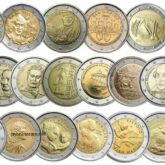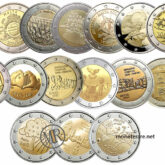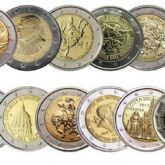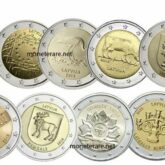Here we will talk about all the french euro coins, that are part of the euro coin collection since the cents and the other denominations become the official coins of the French state in 2002. That is the year in which they enter definitively into circulation, even if in reality the euro had already been adopted in 1999…
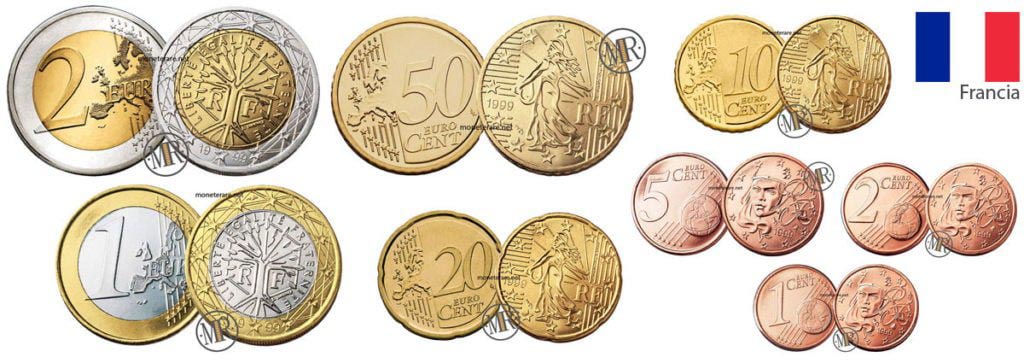
The European history of France, however, has much deeper roots, let’s discover them together.
Introduction to French Coins
France was one of the first members to found the European Union in 1957, before joining on 1 January 1958.
The history of the French currency is even richer. Taking a temporal excursus, we go back to the far Middle Ages, one of the periods of maximum splendor of this nation. A nation that at the time was a Kingdom in which the Louis d’Or coin circulated. A currency that for a long time remained the monetary symbol of France.
Everything remained unchanged until, with the French Revolution of 1789 and with the subsequent Proclamation of the First Republic of 22 September 1792, a new uniform was adopted, namely the “Franco“. This currency also had a long life. In fact, it remained the official currency of France for over 2 centuries.
In 1960 it was reevaluated. New Francs were minted but with a much higher currency, in fact they had a value 100 times greater than the previous coins. 42 years later they will be replaced by the Euro.
The introduction of the Euro
All the French euro coins are minted by the Monnaie de Paris, the state mint which uses the cornucopia as its symbol. The Monnaie de Paris uses several establishments, one of which stands out for its greater importance, that of Parsaac. This is where the Euro coins are still made.
The directors of Mint have been different with different symbols:
- 1999 – 2000: Pierre Rodier – Bee
- 2001 – 2002: Gerard Buquoy – Horseshoe
- 2003: Serge Levet – Heart
- 2004 – 2010: Hubert Larivière – Horn
- 2011 – ad oggi: Yves Sampo – Fleurette d’atelier
To be present in all coins is the National Symbol indicated by the characters “RF” which stands for the acronym Republique Francaise, or French Republic.
These symbols were chosen by a group, chaired by the Minister of Economy and Finance, composed of several personalities, including:
- numismatic
- performers
- former member of the EU Commission Christiane Scrivener
- Members of Parliament
- the Director of the French Mint Emmanuel Constant
- engraver Pierre Rodier
- actress Irène Jacob
- representatives of various professional categories
So let’s see what they’ve worked out specifically. Let’s go and see all the various French euro coins minted, also checking the 2 rare French euros.
1 Cent French Euro Coins
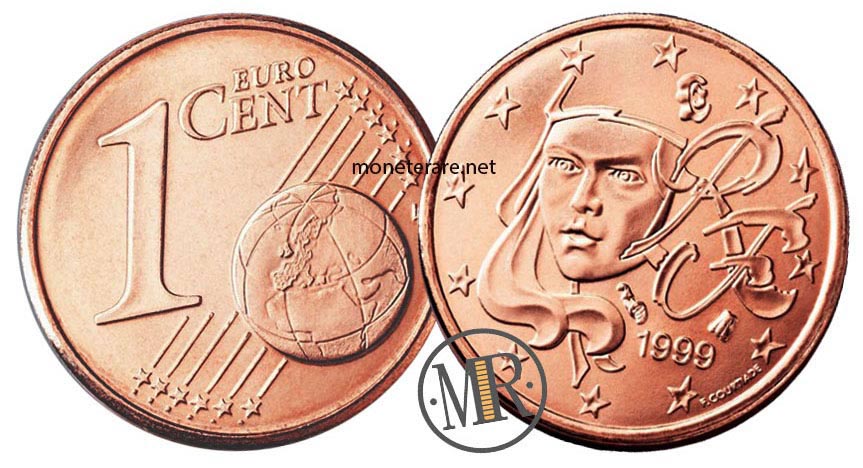
The 1 cent French Euro Coins are obviously the smallest coin for denomination and size. This, together with the other two red cents, have the peculiarity of having in common the same design in the Obverse side of the coin.
On the reverse side there is the Common Face of all the 1-cent coins of the countries that use the Euro.
As for the Obverse, instead, there is the face of the Marianne, symbol of the French Republic. To the right of the image is the acronym “RF”, Republique Francaise.
At the bottom is engraved the thousandth of a coin on which there is the cornucopia, as well as the symbol of the Mint of Paris, and another variable symbol that distinguishes the name of the Mint.
All this is enclosed in a circle of 12 five-pointed stars, symbol of the European Union and, between stars n.4 and n.5, it has the signature of the engraver: F.COURTIADE.
- Materials: Copper-plated steel (steel 94,35 % – copper 5,65 %)
- Thickness: 1.67 mm
- Weight: 2.30 g
- Diameter: 16.25 mm
- Outline: Smooth
- Engraver: Fabienne Courtiade
Value and Circulation of the 1 cent Euro Coin of France
2 Cents French Euro Coins
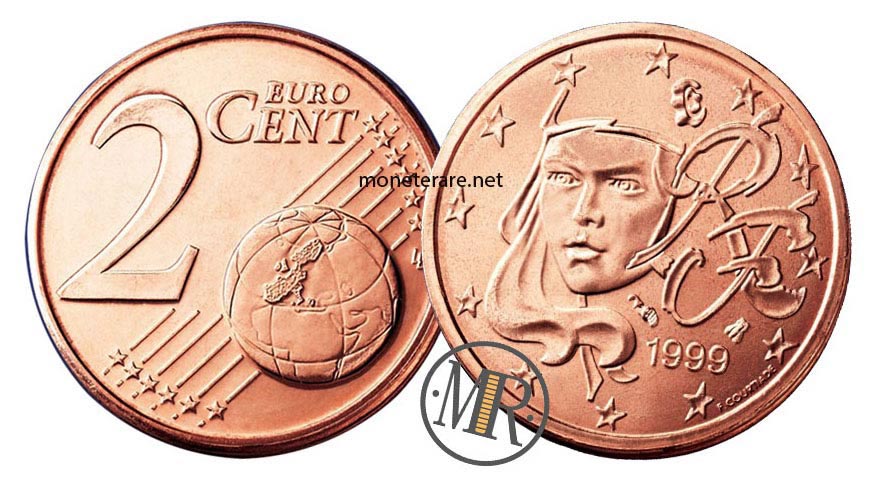
As mentioned before, the 2 cents French Euro Coins also have the same image. That is, there is a portrait of Marianne, symbol of the French Republic.
Obverse: The face is flanked by the two letters “RF” that stand for Republique Francaise and, below, there is the sign of the Mint and the symbol of the Director of the same. Slightly lower down there is the thousandth of minting.
On the outer edge there are 12 five-pointed stars representing the European Union. Under the thousandth of a coin, there is the signature of the engraver as follows: F.COURTIADE.
On the reverse side we find the common face of all the countries of the Euro Zone.
- Materials: Copper-plated steel (steel 94,35 % – copper 5,65 %)
- Thickness: 1.67 mm
- Weight: 3.06 g
- Diameter: 18.75 mm
- Outline: Incused horizontal thread
- Engraver: Fabienne Courtiade
Value and Circulation of the 2 cents Euro Coin of France
5 Cents French Euro Coins

To conclude with the “red cents” we describe the 5 cents French Euro Coins.
The reverse is that of all the 5-cent coins of the States belonging to the Euro Zone.
In the Obverse, on the other hand, the young Marianne is depicted. Her face was chosen because her features embody the desire for a strong and lasting Europe.
The name of the engraver appears on the coin between two of the 12 five-pointed stars on the coin’s edge: F.COURTIADE.
The initials “RF”, which stand for Repiblique Francaise, the symbol of the Mint of Paris and the symbol that distinguishes the Director of the Mint, are also engraved.
- Materials: Copper-plated steel (steel 94,35 % – copper 5,65 %)
- Thickness: 1.67 mm
- Weight: 3.92 g
- Diameter: 21.25 mm
- Outline: Smooth
- Engraver: Fabienne Courtiade
Value and Circulation of the 5 cents Euro Coin of France
10 Cents French Euro Coins
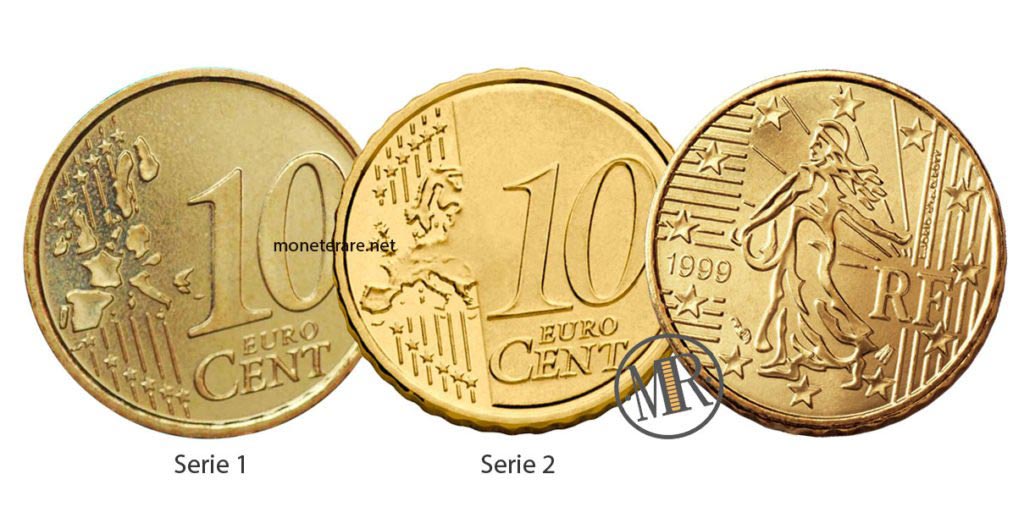
The 10 cents of the French Euro Coins have a completely different design.
In the centre of the obverse of the coin we see The Sower, as well as the symbolic figure already present in the previous French monetisation.
To the right of the woman can be seen the engraving “RF”, Republique Francaise, from which depart several “traits”, sometimes broken by the drawing, and the signature of the author. The latter has been engraved vertically inside two of the six lines that symbolize the flag of France.
To the left of the figure is engraved the thousandth of a coinage horizontally, also shown between lines.
The whole is embraced by 12 five-pointed stars in a circle, the symbol of the EU.
The reverse, on the other hand, presents the common face of all the coins that are part of the Euro Zone. In fact, the first series is the one that goes from 1999 to 2006 that presents the common side with the countries of the Euro Zone separated. Instead, the Second series, which runs from 2007 to the present day, has as its common face the map with the United countries and the addition of the new countries that have joined the Eurozone.
- Materials: Nordic Gold (copper 89% – aluminium 5%- zinc 5% – tin 1%)
- Thickness: 1.93 mm
- Weight: 4.10 g
- Diameter: 19.75 mm
- Outline: Rowed with thick knurling
- Engraver: Laurent Jorio
Value and Circulation of the 10 cents Euro Coin of France
20 Cents French Euro Coins
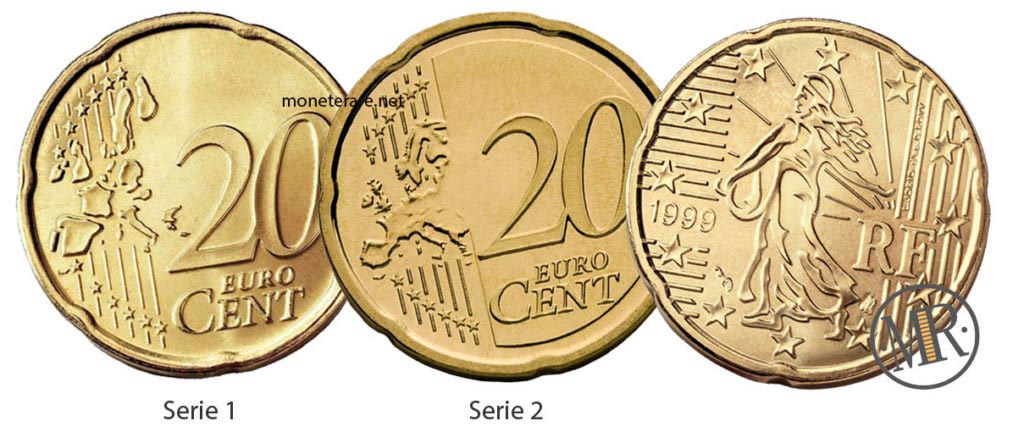
The 20 Euro cents from France have the same image as the 10 cents.
Therefore, in the Obverse there is depicted The Sower, symbolic figure of freedom and hope of an abundant harvest. In the background there are several dashed lines.
To the left of the coin, the thousandth of a coin has been engraved horizontally, between lines that are also horizontal, and under the mint sign.
To its right, instead, is the acronym “RF”, Republique Francaise, and the author’s signature, placed between the first two vertical rows. In the frame of this side there is 12 five-pointed stars, symbol of the EU.
The reverse of this coin is instead that of all the 20-cent coins of the Euro Zone. The first series is the one that goes to 1999 to 2006, this presents as common face the countries of the Euro Zone separated from each other. Second series instead goes from 2007 to today and has as common face the map with all the United Euro Countries and also the addition of the new countries of the Eurozone.
- Materials: Nordic Gold (copper 89% – aluminium 5%- zinc 5% – tin 1%)
- Thickness: 2.14 mm
- Weight: 5.74 g
- Diameter: 22.25 mm
- Outline: Wide knurling
- Engraver: Laurent Jorio
Value and Circulation of the 20 cents Euro Coin of France
50 Cents French Euro Coins

The last French Euro cent is the 50 Cents coin. It also shares the same image as the first two.
The Sower is shown on the Obverse. The original model of this figure was designed by Louis-Oscar Roty (1846-1911), who was inspired by the young Charlotte Ragot, who had the model in 1895.
Represented in graceful vestiges with her hair in the wind, on her right is the symbol “RF”, Republique Francaise, and the author’s signature, both placed between the lines depicted vertically.
Instead, we find the thousandth of minting and the mint sign, to the left of the woman, all decorated with horizontal lines.
Other lines are present on the background of the upper part of the coin. In the outer ring there are 12 five-pointed stars, the EU symbol.
The reverse side of the coin has the same face as the other 50 cent euro coins. The 1st series of 50 cents is the one that goes from 1999 to 2006. As alwauys, the common side shows the countries of the Euro Zone separated from each other. 2nd series goes instead from 2007 to today and presents as a common face all the countries of the Eurozone united with the addition of new ones.
- Materials: Nordic Gold (copper 89% – aluminium 5%- zinc 5% – tin 1%)
- Thickness: 2.38 mm
- Weight: 7.80 g
- Diameter: 24.25 mm
- Outline: Rowed with thick knurling
- Engraver: Laurent Jorio
Value and Circulation of the 50 cents Euro Coin of France
1 Euro French Coin
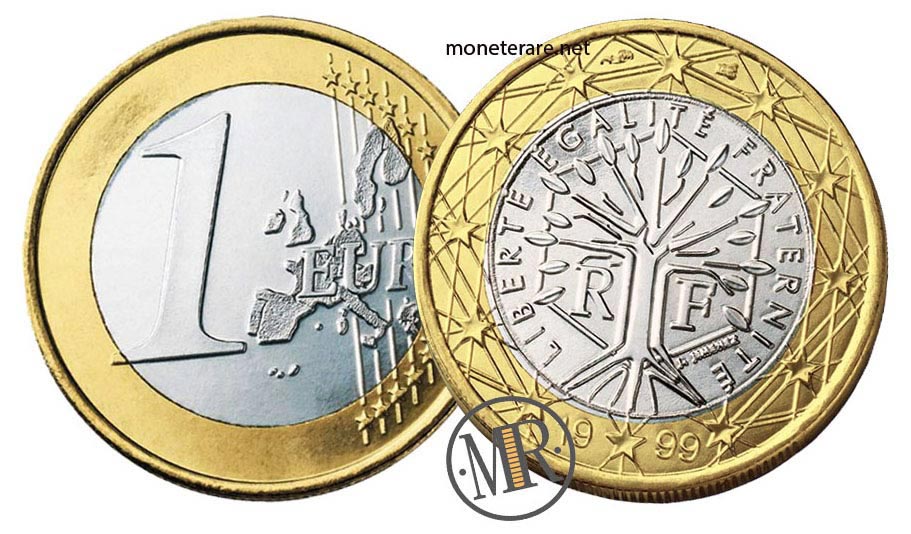
The 1 Euro France bimetallic coin presents a richly detailed design on the obverse side.
At the center is the tree of life, enclosed in a hexagon symbolizing the boundaries of the nation. Around the hexagon there is an inscription, in a circle, with the motto “Liberté Egalité Fraternité“. Between the geometric figure and the inscription, at the bottom, there is the engraver’s signature.
The trunk, with large roots at the base, is located in put to the initials “RF”, Republique Francaise.
On the outside there are 12 five-pointed stars, symbol of the EU, and between them, at the bottom, there is the thousandth of minting.
On the reverse the face is the one common to all the countries of the Euro Zone. The first series of 1 Euro is from 1999 to 2006. The common face represents the countries of the Euro Zone all separated from each other. Instead, the second series runs from 2007 to the present and presents as a common face the countries of the Eurozone united and in addition the addition of new ones.
- Materials: Bimetallic. Outer part: nickel brass (copper 75% – zinc 20% – nickel 5%); inner part: copper-nickel (copper 75 % – nickel 25 %).
- Thickness: 2.33 mm
- Weight: 7.50 g
- Diameter: 23.25 mm
- Outline: Discontinuously grooved
- Engraver: Joaquim Jimenez
Value and Circulation of the 1 Euro Coins of France
Anyone looking for the value of the 1 euro france 1999 coin will be disappointed to see that these are common coins produced in large series.
2 Euro French Coins
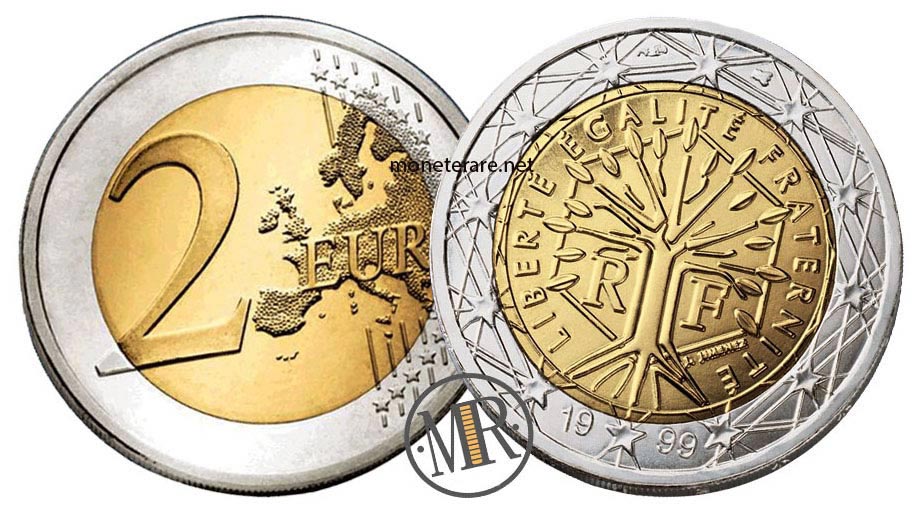
The French coin of the 2 Euro presents to the reverse the common face of the coins of all the countries of the Euro Zone. The Obverse instead presents the same design of the French 1 Euro coin. Even here, the 2 Euro coin also has two series: The first series is from 1999 to 2006, the common side sees the Eurozone countries separated from each other. Instead, the Second is the series coined from 2007 to the present day that stylizes the countries of the Eurozone united with the addition of the new countries of the Eurozone.
Remember that there are many others French 2 euro coins that you will find in the page of the French 2 euro commemorative coins.
The centre of the coin shows a stylised tree symbolising life, growth and continuity. Its trunk is placed in the middle of the initials “RF”, Republique Francaise.
The tree is surrounded by the inscription “Liberté Egalité Fraternité” and is all enclosed in a hexagon. On the edge, decorated with lines, there are 12 five-pointed stars, symbol of the EU.
The thousandth of minting can be seen, engraved at the bottom with a star and a cornucopia in the middle, in the other and next to the first star.
- Materials: Bimetallic. Outer part: copper-nickel (copper 75 % – nickel 25 %); inner part: nickel brass (copper 75 % – zinc 20 % – nickel 5 %).
- Thickness: 2,20 mm
- Weight: 8.50 g
- Diameter:25,75 mm
- Outline: Finely knurled with the “2” pattern in incuse, followed by two five-pointed stars, repeated alternately from bottom to top and vice versa.
- Engraver: Joaquim Jimenez
Value and Circulation of the 2 Euro Coins of France
As can be seen from the table below, the 2 rare French euro coins are mostly, speaking of the first series, the 2 euros of 2004. While talking about the second series, the 2 euros French rare are the first ones from 2007 to 2010 and the last one of 2019, which has the highest quotation of over 30€.
Those looking for the value of the 2 euro france 1999 will be disappointed to see that they are common coins.
Do you want to learn more about Euro Coins?
- Two pages you can’t miss: 2 Euro Commemorative Coins and Rare Euro Coins
- The precious Vatican euro coins can be seen here and also the San Marino euro coins
- Here you can see the Malta euro coins and here the Cyprus euro coins.
- Euro coins from Germany can be found here and Euro coins from Estonia and Latvia Euro Coins here.
- Euro coins from France can be found here, as well as Euro coins from Austria.
- Also of great interest are the euro coins from Greece and the euro coins of Luxembourg.
- Here you will find Lithuania Euro coins and Andorra Euro coins
- We also talked about Slovenian Euro coins and Slovakia Euro coins.
- Check also Spanish Euro Coins here and Euro Coins of Portugal here.
- The Netherlands euro coins can be found here and the Ireland euro coins here.
- All precious Monaco Euro coins are here and Belgium Euro coins here


